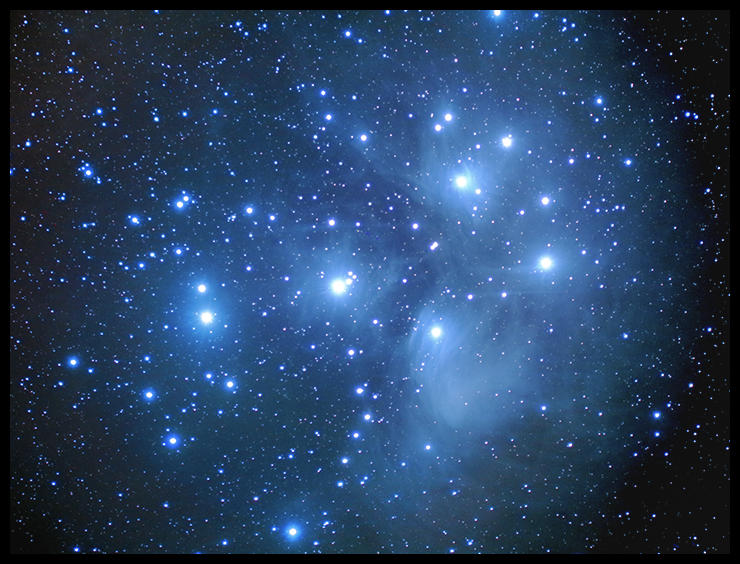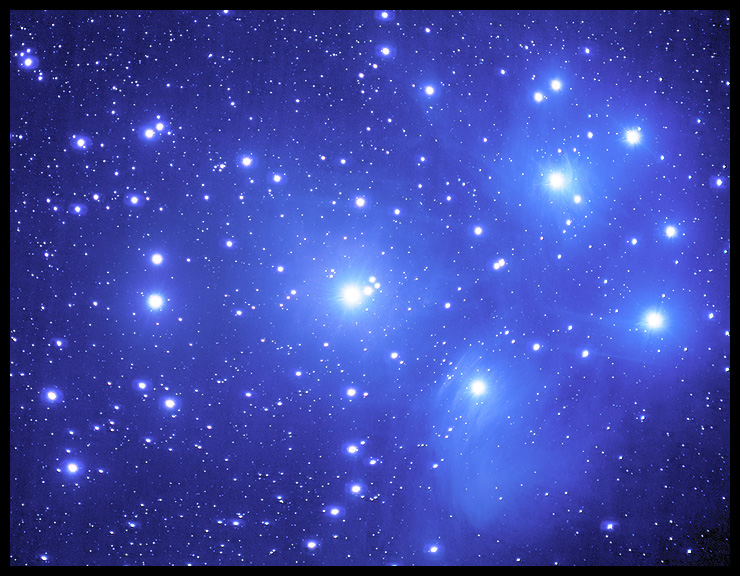11/07/2013. Wide, wider, too wide? I put the 6D behind the 5-inch F6 with the 0.75x compressor in place and had a terrible time getting well-illuminated full fields. Here are a couple of crops:

Coccoon Nebula and Environs
A-P 5" F6 @ F4.5 with Baader Fringe-Killer filter
17x180s, Canon 6D, iso 1600
Cropped.
The magenta smudge is the Coccoon Nebula. From dark skies, I've used binoculars and widefield telescopes to try to follow the dark nebula trailing away to the left all the way back to open cluster M39 and on to the vicinity of the North America Nebula (NGC 7000) in Cygnus (see previous page). Tonight, I was mostly killing time waiting for the Pleiades to clear the boughs of Bird Feeder Tree. I also shot a dozen dark frames at 50°F to use with tonight's images. Try a mosaic to get M39 and the Coccoon. Ideally, I'd like enough S/N to show the dark cloud as more than a silhouette, but that may require darker skies than these.
Then I started an all-night series to try to catch the nebulosity wreathing the Pleiades. Unfortunately, even though the batteries lasted all night (I swapped in a fully charged battery about 1:00), the sky hazed up and I only got about 90 minutes of usefully clear air. The result is OK, but thin data can only be pushed so far:

M45, the Pleiades
A-P 5" F6 @ F4.5 with Baader Fringe-Killer filter
32x180s (1h 36m), Canon 6D, iso 1600
Cropped.
Next time, let's try it without the compressor. If the full frame is illuminated, I'll have about as wide a useable field, a more generous image scale to show finer details, and more pixels.
11/08/2013. The Canon remote release and timer is powered by a CR2032 coin-style lithium battery. It died while I shot M39. I stole a battery from one of Amy's decorative candles. It worked for a couple of hours while I shot the connecting frame with the Coccoon, and then it died, too. Now the Pleiades are once again above the trees and the sky is pretty good. So what to do? I've set the camera on "30s" rather than on "bulb" and I've locked the shutter open using the manual switch on the remote timer. By the time the Pleiades hit the trees, I could have as many as six hundred 30-second exposures on the card. I'll either have to be very picky or very patient and systematic to work with so many. I'm not sure 30s is long enough to catch much (F6 vs F4.5 is about a stop; then 1/6 of the exposure time compared to last night is 1/12 of the exposure on each frame which means each sub will be about 3.5 stops darker than before). I increased the ISO to 3200 which gets one stop back. With that many to stack, electronic noise is not going to be an issue. So, in the end, each frame will be 2.5 stops dimmer. I could go to 6400 ISO or higher. On the other hand, last night's frames were greatly over-exposed... so let's just see what we find in the morning. If I can get good stuff at 30s, polar alignment in the field (if I ever get to the field) will be a snap. This is moot, I think, because I beleve I can reproduce the excellent alignment I have in the back yard using the RAPAS finder that A-P introduced recently. The G11, however, might call for shorter subs owing to less refined alignment (and less refined everything, come to that). Anyway, sleep on it, literally.
In the morning I found 600+ photos of the Pleiades. I threw out all those with twilight encroaching (~50) and all those with excessive haze (~175) and a few more here and there. I was left with 392, 30-second frames. I processed them in 9 separate batches and combined the intermediate results. S'OK, but it was a ton of work and I'm not particularly thrilled with the payoff. The blue light of the stars is scattered more by high haze and the nebula is less defined for that reason. By which I mean, it's not a fair comparison and the shorter exposures would likely work much better under clearer skies. It's still a ton of work to combine so many. Keep the option of using such short exposures without a timer in your pocket in case it is needed someday. But given the choice, buy spare batteries and use sane sub-exposures.

M45, the Pleiades
392 x 30s (3h06m total)
5" A-P @ F6, Diagonal, Baader Fringe-Killer filter
Canon 6D, iso 3200. Cropped.
The F6 configuration requires the 2-inch diagonal to take up back focus which has the happy effect of putting the camera's LCD panel in a very convenient place.
11/10/2013. A fresh CR2032 in the Aputure aftermarket timer/remote release for the camera let me set 180s exposures with 15s cool-down periods to run all night. The sky remained reasonably clear. I shot flats through a diffuser at twilight.

M45, the Pleiades
85 x 180s (4h 15m total)
5" A-P @ F6, Diagonal, Baader Fringe-Killer filter
Canon 6D, iso 1600. Slightly cropped.
There's more extensive nebulosity in this field than shown in any of these views. Darker skies, anyone? Working on it. All in all, considering the exposure times, I think the F4.5 configuration is the way to go afterall.
The Aputure aftermarket timer and release for the Canon turns out to be a battery hog. The same battery in the original Canon timer lasted forever (until the timer failed for unknown reasons), but damned if I'm paying for another of those. I've ordered a different model that takes AAA batteries. More about that when I know more.
Except where noted, deep-sky photos are made with an SBIG ST2000XM CCD behind a 10-inch Astro-Tech Ritchey-Chretien carried on an Astro-Physics Mach1GTO. The CCD is equipped with Baader LRGB and 7nm H-a filters. The internal guide chip of the CCD most often keeps the OTA pointed in the right direction (I'll let you know when a Meade DSI and a separate OAG or guidescope takes its place). Camera control and guiding are handled by Maxim DL 5.12. The stock focuser on the AT10RC has been augmented with Robofocus 3.0.9 using adapters turned on the lathe downstairs. Maxim performs image calibration, alignment, and stacking; Photoshop CS4 and FocusMagic 3.0.2 take it from there. Gradient Xterminator by Russell Croman and Astronomy Tools by Noel Carboni see their share of work, too. Beginning in May 2013, PixInsight has taken over some of the heavy lifting for transfer function modification and deconvolution.
:: top ::